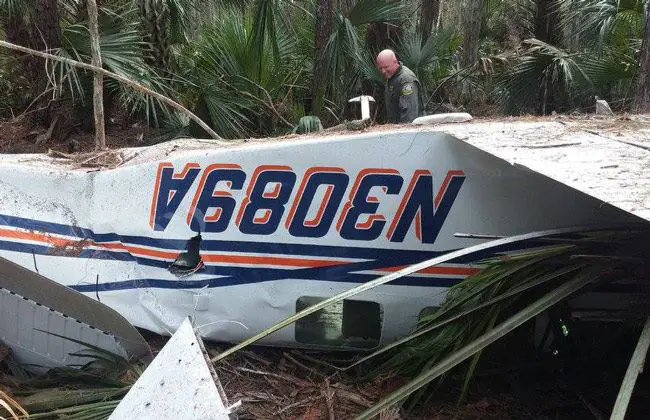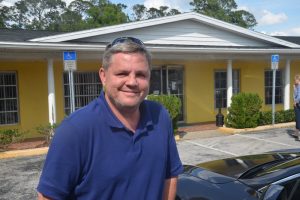
Two and a half years ago Joel Fallon and Josh Rosa decided to take a 15-minute flight out of the Flagler County Airport to DeLand for lunch and to pick up a vacuum pump. Fallon at the time was 50 and the owner of Granny Nannies of Flagler and St. Johns counties. Rosa was 36 and the owner of Flagler Air Exchange. Both were experienced pilots: Fallopn had flown 420 hours, Rosa 2,500. They took off at about 1:30 p.m., with Fallon at the controls of a Beech 36 single-engine plane.
It was a clear day, light winds. Three or four minutes later, they crashed in the the western woods of the Plantation Bay subdivision. The plane, an unrecognizable mass of scrap, was a loss, yet somehow both Fallon and Rosa survived, albeit with extensive injuries that required a long recovery.
Last week, the National Transportation Safety Board, which investigates all plane crashes, issued its final report on the Plantation Bay crash of Nov. 9, 2016. It was inconclusive. The crash was attributed to “A loss of aircraft control for reasons that could not be determined because postaccident examination did not reveal any evidence of preimpact mechanical malfunctions or failures of the flight controls that would have precluded normal operation.”
The investigation is ending inconclusively, but it sheds light on cool-headed measures Rosa took immediately before the crash that strongly suggest his skills and last-second maneuvers likely prevented the crash from being fatal to him and Fallon.
Fallon told investigators that after take-off he’d leveled off at 2,000 feet, the flaps and landing gear retracted, and trimmed the airplane for level flight. The autopilot was not engaged., according to the final report. Fallon said “the airplane then ‘suddenly’ rolled to the right and he was unable to stop the roll with opposite aileron,” according to the report. “The airplane continued to roll inverted” and started to dive.
Rosa then took over the controls, shutting off the engine to avoid a fire if they crash landed–a decision that likely saved their lives, since they were about to crash. From the time the roll began until the airplane was inverted was about two seconds, Rosa told investigators.

Rosa “pressed full left rudder to bring the airplane back to level flight; however, the airplane was ‘sliding to the right’ in a descent,” the report found. He’d leveled the plane at about 300 feet. Rosa “slowed the airplane and flared into a stand of trees.” He recalled the wings striking the trees and “bouncing around like a ping pong ball” before coming to rest.
Very likely thanks to Rosa’s earlier decision, there was no fire. The men called 911 on their cell phone. A golfer on the Plantation Bay course had also seen the plane go down and immediately called 911.
NTSB’s examination of the wreckage revealed the plane first struck a 30- to 40-foot-tall palm tree with its right wing and then struck a second tree with the right wing. A 9-foot-long section of the right wing separated from the plane, which hit the ground about 125 feet from the first tree impact and ended up inverted against a third tree. The engine and the propeller both separated from the airframe and were found forward of the main wreckage.
“Flight control cable continuity was confirmed from the flight control surfaces to the cockpit input controls for the rudder, elevator, and aileron,” the report states, and continues: “The right aileron UP flight control cable was separated at the turnbuckle which was located inside the cabin and the aileron balance control cable was separated in the right wing. The separated turnbuckle and a section of the aileron balance control cable were sent to the National Transportation Safety Board’s Metallurgical Laboratory for further examination. Examination of the separated cable ends revealed they were both separated due to overstress.”
Examination of the engine revealed nothing abnormal. The plane had last been inspected less than seven months before the crash, when it had accrued 5,886 hours of flight, and had flown another 23 hours since. The plane was owned by James Gardner, the Flagler County property appraiser.
In February 2018, Fallon wrote on his Facebook page: “Today Josh and I went to see the crashed airplane. The NTSB just released it. We went to get our personal items out ( nothing was there ) just memories. Even the guy who showed us the plane could not believe we both survived based on the conditions of the plane. Special thanks to Josh Rosa, he is a good friend and a strong supporter.”





























Kathy says
God was watching over you that day. Thanking Him you both are alive. You and your loved ones are very blessed.
palmcoaster says
There was a similar accident on a small plane in the late 1990’s with a student and the pilot trainer at the controls of their Ormond Beach Airport base. They were practicing takes offs and landings and for no apparent reason the plane went out of control on a spin and they just manage to soften the crash on some trees….suffering massive injuries that took also years of recovery. The FAA also found no mechanical failure up front but the instructor of British origin not satisfied with the outcome engaged a legal team from out of state that took 10 years of investigations, discoveries and court hearings and finally was proven that a defective manufactured replacement part of a batch of good ones was not pulled off from marketing and was what caused the failure. As a matter of fact few of those defective manufactured parts were never pulled off the batch from marketing. After 10 years of litigation the lawsuit was settle and the instructor and student pilot were awarded 52 millions in damages over negligence to share and pay also the 10 years of attorney’s fees.
I a different issue I am also concerned that some or maybe more than we know of the small planes flying among us are not required liability insurance by the FAA…if true I will say WHY?
Concerned Citizen says
I remember that crash and how fortunate they were to survive it.
I have about 2,000 hours myself in a single engine aircraft along with an Instrument rating and night rating. Though I very rarely fly at night as I don’ like it. Thankfully in all my years of flying I have never had an inflight emergency.
Aircraft are mechanical and have a lot of moving parts. Just like a car they break down even with proper maintenance. Unlike a car you can’t pull over. Flying really is safe though. I prefer flying over driving.